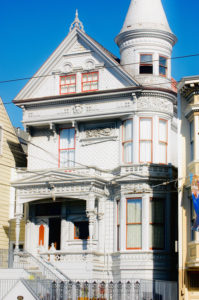
959 South Van Ness Avenue
photo by Primo Lagaso Goldberg
Sitting submerged in movie theatre darkness at the iconic Roxie Theater on 16th and Valencia, I await the screening of one of the newest cultural conversation starters in the Bay Area: the movie The Last Black Man in San Francisco. Directed by Joe Talbot and starring Jimmie Fails, both San Francisco natives, The Last Black Man in San Francisco tells the story of Jimmie Fails, a character with the same name as the actor who plays him and his friend Mongomery “Mont” Allen, played by Jonathan Majors. The film follows their attempt to reclaim Fail’s family home, an elegant and classic Victorian painted white with gold and red trim.
Jimmie claims the house was built from its foundation by his grandfather in 1946. The home in question stands off of Golden Gate and Fillmore in the movie, but at 959 South Van Ness Avenue in reality. In the film, the house has new occupants and owners. Jimmie complains that the current residents don’t take as much care of the home as they should. He constantly sneaks onto the property to do upkeep. The audience follows his journey to care for the house, to reclaim it and his own history. As he reconnects with family members, he is forced to face the reality of his family’s myths.
The movie reminds us all of the brutal reality of gentrification in San Francisco.
The main tension of the film is the loss of Jimmie’s sense of place and belonging in the city. Though Jimmie’s family is scattered to the wind, he remains stubbornly tied to the city and the house. There are moments where it seems that, though young, Jimmie is timeless. He lets the world drudge by around him as he daydreams about what used to be. One scene shows Jimmie flying parallel to an iconic cable car down California Street on his skateboard and evokes feelings of beautiful nostalgia for classic San Francisco. Even with this ideal picture, Jimmie never seems to really see the reality of his situation. He and Mont both struggle internally and externally with conflicts both material and emotional. The story is visualized in beautiful wide-angle shots of golden hour San Francisco. The cinematography is breathtaking. Each shot seems to be a painting of some part of the city, romantic and reassuring, or heartbreaking.
Despite all this beauty, however, I emerged from the Roxy Theater onto the grime of Valencia street at night and was not entirely satisfied. Perhaps my young eyes are biased and had no context for the tale it told of the marginalization of the stories of people of color in San Francisco. Perhaps not having grown up here, I am missing some deep visceral connection to Jimmie’s plight. Whatever it might be, I was born here, left and came back and live here now, but still felt the plot of the movie was unclear at times and that the pacing was slow. Beautiful, but slow.
It was not until maybe halfway into the film that it became clear to me what The Last Black Man in San Francisco was actually about and even once that was established, many scenes initiated side plots that never seemed to resolve. The movie seems to culminate with an impromptu one-man play performed at the house by Mont where he blatantly confronts Jimmie about refusing to acknowledge his reality. This scene is powerful and speaks bluntly about racism and gentrification in real life. The plot quickly de-escalates afterward and a pseudo-resolution comes in that everything returns to normal. The world keeps turning. This ending left me wanting more, however, it is good practice for us to be okay with nontraditional endings as they are more authentic to our real lives.
As a piece of art and visually speaking, The Last Black Man in San Francisco is a delicately crafted, thoughtfully created, beautiful piece of contemporary cinema. However, it lacks a core story to follow and leaves the viewer feeling incomplete. Maybe a slightly nontraditional plot style suits Jimmie’s nontraditional circumstances. Many critics prioritize the movie’s cultural significance. One thing I am sure of is that it is a beautiful movie. Perhaps on the second or third viewing, I will find the plot as breathtaking as the imagery.
If you ever need to be reminded of San Francisco’s complicated and ugly beauty, set aside two hours, pop some popcorn and watch The Last Black Man in San Francisco, available for purchase on YouTube and Amazon Prime.







